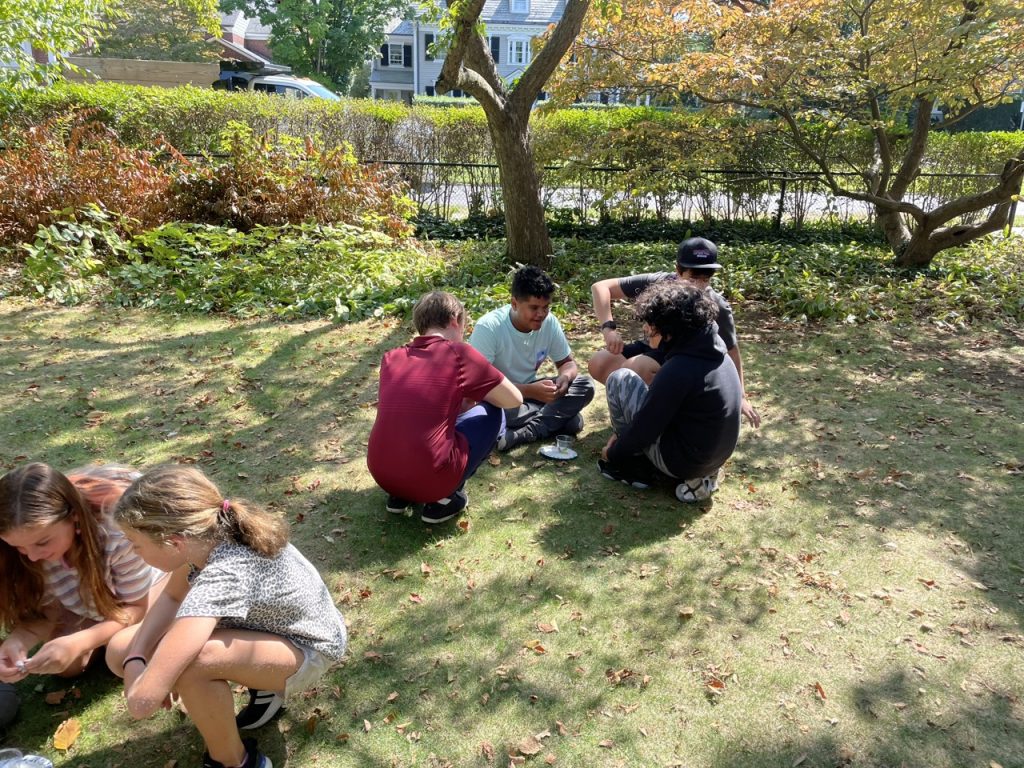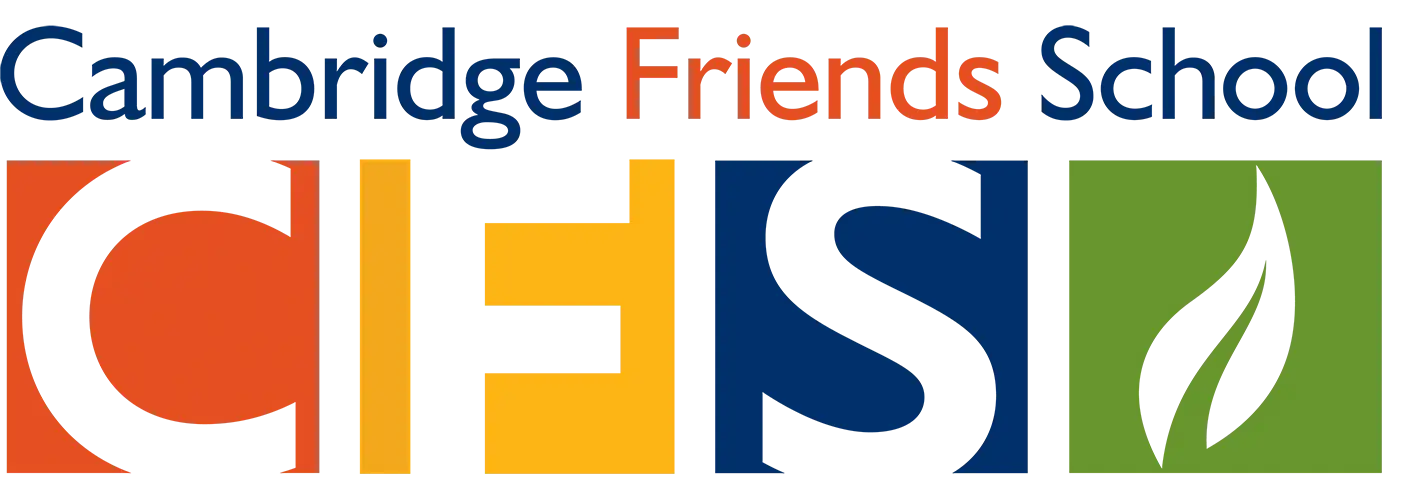Middle School
Building the Self, as Learner and Human
The Middle School years are a complex time of self-discovery, growth, and learning. Academically, middle schoolers question everything, and are driven to think critically, yearning to make their own connections and to be trusted to come to their own conclusions. Socially, middle schoolers place great importance on peer relationships, but still rely on the grown-ups around them in many ways. With one foot still in childhood and one stepping into adolescence, middle schoolers are many things all at once.
At Cambridge Friends, our Middle School program supports students through these “middle years”, challenging them and creating a space that feels comfortable enough for them to experiment, make mistakes, and learn. Students find that their teachers are there to guide and encourage, whether it’s understanding a tough math problem or a complicated friendship, but also push them to take on intellectual risks. Our program aims to prepare students for entry into excellent high schools and beyond, with challenging coursework in the sciences, mathematics, social sciences, literature, writing, and the arts.
With our Quaker values woven throughout the coursework and each day, we seek to instill empathy and kindness along with the ability to tackle challenging academics, and in the end, graduating compassionate leaders, confident learners, and people of character.

Stepping into Independence
Starting in 6th grade, students transition from a homeroom model to an advisor model for the remainder of their time at CFS. Each grade has a dedicated advisor that tracks each student’s progress and ensures that they are supported and part of the community. But the students also take on the responsibility of moving from classroom to classroom and subject to subject throughout the day, caring for their class materials, assignments, and managing their time and transitions more independently, as they will do in high school.
There are four core subject areas in our middle school program:
-
Science – Biology, Earth Science, Chemistry, and Physics
-
Math – Up to Geometry/Algebra II
-
Humanities – Early life and civilizations, Foundations of democracy and US History, Identity and Community
-
Spanish and Latinx Studies – Up to Spanish II, and topics including ancient Latin American civilizations, Latino immigration, resistance and solidarity movements
Those core subjects are augmented and interwoven by courses and curriculum in drama, visual arts, music, physical education and atheltics, health, wellbeing, and affinity/identity and all are informed by our Quaker values.
Explore By Subject

Science
The Middle School Science curriculum covers a lot of ground. Starting in 6th grade with Life Sciences, they investigate life: What makes something “alive”? What are the building blocks of life? How does life persist? Going from small to big, they study cells and cellular processes, explore genetics, investigate fossils, look into evolution and classification, and finish with ecology.
In Grade 7, students “dig” into Geology and Earth Sciences. From rocks and minerals to tectonic plates, from geography and mapping to weather and climate, from atmosphere to astronomy, seventh graders become well versed in our world. Over the course of the year, they have opportunities to get hands-on with gems and minerals, do soil testing, understand the big forces of plates and how they connect with earthquakes and volcanos, learn to read topographic maps, dig into climate and climate change through weather, and go beyond the earth to study the solar system and beyond with the exoplanet project.
Grade 8 focuses on the physical sciences, including Chemistry and Physics. In learning about properties and states of matter, students create their own solar oven to experience the principles in action. They learn about atoms, the Periodic Table, and atomic bonding. They test the law of conservation of mass, explore chemical reactions, create colorful paints using acids and bases. They learn about the physics of motion, gravity, and Newton’s laws of motion and apply them in a Rube Goldberg machine activity.
Through hands-on labs, creative projects, group work, and independent study, CFS students gain a solid foundation for future learning and work in the sciences. With each of these topics, the students get hands-on with their learning, applying the concepts in practical or creative ways that let them demonstrate the depth of their acquired knowledge.
 The Earthquake Lab
The Earthquake Lab
In 7th grade, students learn about earthquakes and participate in an earthquake lab. They start by learning some basics of earthquakes and then read some San Francisco-area newspaper articles to learn about different aspects of earthquakes and some of the lesser-known risks of earthquake-prone areas. Then they get a chance to take that accumulated knowledge and work together on an earthquake design challenge.
Stepping into the role engineers, the students design their own buildings that can absorb shock in an earthquake, aiming to design a structure with multiple floors and being at least 25 centimeters tall that can withstand at least 30 seconds of shaking. Students enjoy coming up with ingenious ways to use the materials, which include sugar cubes, glue, jello, graham crackers, and toothpicks. Whether their structure tips over, crumbles, or withstands the earthquake challenge, the results always shake them up and the engineering principles stick with them!
Math
The Middle School Math curriculum at Cambridge Friends is designed to teach our students to learn to reason effectively, share their mathematical thinking both verbally and in written form, and develop strong mathematical practices as they delve into the concepts. Using the 5 E instructional model (Engage, Explore, Explain, Elaborate, Evaluate), students build and reinforce their math skills while applying them to real-world situations and scenarios. At the end of middle school, students will be prepared to go on to Geometry or Algebra II as freshmen in high school.
In Grade 6, the Math curriculum covers area, ratios, rates and percentages, dividing fractions, arithmetic in base 10, expressions and equations, and rational numbers. In Grade 7, students study scale; proportional relationships; rational number arithmetic; expressions, equations and inequalities; angles, triangles, and prisms; and probability and sampling. In Grade 8, they study arithmetic of real numbers, linear equations and inequalities, exponential functions and polynomials, and dip into high school math concepts like radicals and geometry, data analysis and visualization.
Rather than focus on rote practice, our program asks students to apply the eight Standards for Mathematical Practice to demonstrate their mastery of a topic. The eight standards are:
-
Make sense of problems and persevere in solving them.
-
Reason abstractly and quantitatively.
-
Construct viable arguments and critique the reasoning of others.
-
Model with mathematics.
-
Use appropriate tools strategically.
-
Attend to precision.
-
Look for and make use of structure.
-
Look for and express regularity in repeated reasoning.
Fermi Challenges
In 6th grade, students end the year by solving Fermi Challenges. These complex problems help students engage their math skills and their creative minds at the same time. Balancing data, calculations, and educated guesses, students discuss the challenges together and come up with ways to test their hypothesis through calculations.
Humanities
Humanities at CFS is multifaceted. Through reading, writing, and discussion, students not only learn about literature, history, and society but also to evaluate them, and explore them from multiple perspectives. Using a variety of historical and contemporary texts, they learn to make connections between individual experiences and the greater world we live in.
In Grade 6, students explore perspective. Looking at a range of history and story, they explore how we interpret the start of our world with the Big Bang to the formation of civilizations and then into the future. Asking questions like “Why do we look at things from far away and close up?”, “How can looking at the same information from different perspectives pave the way for progress?”, “Why do societies collapse?”, and “What are the positive and negative impacts of interconnection?”, students delve into history, literature, and society.
In Grade 7, students explore the foundations of democracy in the US, focusing on the question of who writes history and how perspective impacts how we describe history. They explore what it means to be an engaged citizen in our contemporary democracy, and consider the role that media literacy plays in democracy. They delve into the ideas and philosophies that inspired the Founders, and consider the impact decisions made more than 200 years ago have on our lives today. With emphasis on the idea of historiography, students interrogate the ideas and motivations behind storytellers in both historical and fictional texts.
In Grade 8, students investigate the relationship between identity and community, and how our identities form the lenses through which we connect with others, interpret literature, art, and the world around us, and structure our political lives. With focus on queries such as “How do our identities shape our lives and influence our beliefs?”, “What tools do we have to grow as individuals and to realize healthier, more equitable communities?”, “What does an ideal community look like, and is it attainable in our contemporary world?”, they analyze texts, write, and discuss to gain a nuanced understanding and solid critical thinking skills. The curriculum is also structured to introduce students to a high school-level workload and high school-level study habits and projects, including a multi-phase, long-term research project.
The Dystopia – and Hero – Project
In Grade 8, as part of their study of communities and what makes for an ideal community, students get to take those learnings and try their hand at world-building.
Working together in groups, their task is to imagine a complete dystopian society, including the laws, structure of government, culture, religion, climate, social structures, technology, climate, and day-to-day experience of the citizens of their dystopia – and create a “hero” that might be able to dismantle the dystopia. As part of the project, each group is asked to generate creative writing and visuals about the features of their dystopia, as well as an origin story and hero’s journey story arc for their hero. At the end of the project, each group presents their dystopia to the class to compare and discuss.
Spanish & Latinx Studies
Spanish at CFS is a whole body experience. Students get a chance to learn and practice language in many different activities, whether it’s conversing with classmates, creating and playing trivia games, crafting sculptures while learning about culture, making food to share with the class, or movement games based on vocabulary. They also get to practice their language skills through projects and presentations. The classes are student-centered in a big way: the teacher may come with the structure for the day but the students participate in how the instruction plays out. They practice language with real life situations which connects language to their lives. The many modalities encourage students to take risks and practice language in a space that welcomes experimentation. Progressing on a continuum from 6th to 8th grade, students work to extend their vocabulary, understanding of grammar, comfort with tenses, and fluidity with language. At the end of middle school, CFS graduates are prepared to enter Spanish II in high school.
In addition to the study of language, students learn about humanities, art, culture, social justice, and society through our Latinx Studies program. Each grade-level focuses on an integrated unit ranging from early Latin American civilizations, ancient civilizations, Spanish colonization, immigration, US colonization, imperialism and social/solidarity movements in the United States. The program is a collaborative effort across the multiple subjects: Spanish, Art, and Humanities.
Imaginary Countries
In Grade 7, the students worked on a project (an idea of one of the students) where they created their own Spanish speaking country, designed a flag for their country, and crafted an alebrije – a fantastical creature painted with bright colors and designs – of their choice. In collaboration with their art class, the students each carved an alebrije out of wood, and also worked together to create a large alebrije as a group.
Arts
In Middle School, students immerse themselves in both visual and dramatic arts. In Drama, students learn scriptwriting and adaptation, creating and embodying a character, projecting and emoting for the stage, blocking, sound and lighting, costume and scene design. Starting with adapting short stories into scripts in 6th grade, the students move onto production of a one act comedic play in 7th grade, and then in 8th grade they complete a full two-act production or musical. The 8th grade Drama curriculum also includes oral presentation and interviewing skills to prep for secondary school applications.
In Visual Arts, students explore expression in a variety of media. Whether it’s painting portraits in acrylics, needle-felting fantastical animals, printmaking with positive and negative space, or collaborating with other classes like creating alejibres with Spanish or creating sets and props for Drama, students have all kinds of opportunities to find their voice and hone their skills in visual art. And of course, optional instrumental and ensemble offerings, like Jazz band, are available to support students’ musical expression and development.

Childhood Story Skits
In 6th grade Drama, students reflect back on the important stories of their early childhood and select a number to adapt into short skits. Starting from story selection, students discuss what makes a good scene, dramatic story, and visual piece for the stage. They come to consensus on which stories to adapt and then work to translate them to script form, adding dialogue, setting scenes, extending the story to make a good play for their young audience, the Pre-K to Grade 2 classes. In art, they design and create the costumes and props they’ll need, and they learn about lighting and sound. Through tech rehearsals and running lines at home, they work hard as the show day arrives. With one show for the younger grades and one for families, everyone gets to enjoy the show!
Whole Child
Surrounding and threaded through the core academic subjects are classes, events, and themes that support the growth of whole child. Whether it’s the quiet of a Tuesday morning Quaker Meeting for Worship at the start of the day or conversations about creating a healthy body and mind in Chat class or pushing themselves in gym class or on the sports field, the students are encouraged and guided as they grow and explore who and how they are in the world.
With leadership opportunities like the SPARK student government and spending time with their younger grade buddies, they find they are looked up to and respected as the role models in the student community.
Affinity groups connect students from middle school with not only teachers but also lower school and early childhood students who share a similar lived experience.
And woven throughout every day and every class are the Quaker values of Simplicity, Peace, Integrity, Community, Equity, and Stewardship – testimonies that these middle schoolers have gained a richer and more nuanced understanding of throughout their time at Cambridge Friends.

Field Trip to the Quaker Meetinghouse
Each year at the start of the year, the middle school takes a walking field trip to the Friends Meetinghouse near Harvard Square. Over the course of the day, they reconnect with each other (or come to know the new students!) through group activities, discussions, and team challenges under the guidance of the middle school teachers. They explore the quaker testimonies of Peace, Stewardship, Integrity, Community, Equity, and Sustainability together, reflecting on each and discussing how these show up in their lives. This field trip is a great way to return to the community of school after the long break of summer.







 CFS graduates students who are academically accomplished, emotionally unafraid, moral leaders.
CFS graduates students who are academically accomplished, emotionally unafraid, moral leaders. 